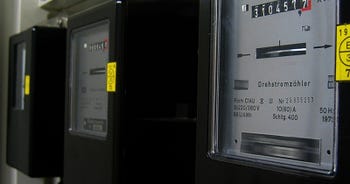A guide to energy-efficient lighting: How it can save your business money
From operating factory machines to serving up coffee to commuting customers, it's clear no matter the type of business you run, your employees need to have good lighting in place to be able to see and do their work properly.
But shining the light on the best energy-efficient lighting that still does the job whilst keeping costs low, can sometimes be part of the challenge.
But if you choose right, energy-efficient lighting can really make a difference when it comes to cost-savings and doing your part for the environment. In this guide we’ll explore what exactly energy-efficient lighting is, the benefits it can have on your business and some of the best options you can choose.

Five-point summary
- Energy-efficient lighting can save businesses money and benefit the environment. It works by reducing electricity consumption by using bulbs and fixtures that consume less power.
- Benefits for the environment include reduced greenhouse gas emissions, lower energy demand, resource efficiency, reduced heat emissions, and less light pollution.
- LED lighting is the most energy-efficient option, lasting longer and using up to 80% less energy than halogen bulbs. Other benefits of energy-efficient lighting include lower maintenance costs, improved lighting quality, and flexibility in lighting control.
- Factors to consider when choosing energy-efficient lighting include lighting goals, energy efficiency, type of lighting, fixture compatibility, dimmability, lifespan, initial costs, and government grants.
- Proper disposal is essential, as LED bulbs can be recycled, while CFLs containing mercury should be taken to recycling centres.
What is energy-efficient lighting?
Energy-efficient lighting is all about getting the light you need without guzzling down tons of electricity. The aim of energy-efficient lighting is to reduce the amount of electricity used to produce light, leading to lower business energy bills and a smaller carbon footprint.
The cornerstone of this is to use light bulbs and fixtures that provide all the illumination you need while consuming significantly less power compared to traditional incandescent bulbs.
Compact fluorescent lamps (CFLs) and light-emitting diodes (LEDs) use a lot less power and shine just as or even brighter than normal bulbs.
What types of energy-efficient light bulbs are available?
There are a few different types of energy-efficient light bulbs to choose from. Here's a breakdown of what's available and what they're useful for, to help you make the right choice for your business/
- LED bulbs - These super-efficient bulbs can last up to 25,000 hours, and only cost between about £2 and £6 to buy. Running costs are low at around £1.70 a year. These are great for everyday use and best for offices, retail spaces, and warehouses.
- CFL (compact fluorescent lamp) - These cost between £1.50 and £3 each and can last for up to 10,000 hours. Running costs are about £2.50 a year. Good for steady, regular use, making them ideal for desks, corridors, and kitchen areas.
- Halogen energy savers - At between £1 and £2 each, these are among the cheapest to buy, but are less efficient than others - they usually only last for about 2,000 hours. And running costs are higher, at between £7 and £8 a year. They give a warmer light but don’t last as long, and are best used in spotlights and meeting rooms.
- Smart LED bulbs - A bit more pricey at between £5 and £20, but running costs stay low at around £1.50 to £2 per year. They can also be app or voice-controlled, meaning they're ideal for automation and energy tracking. Perfect for smart offices and flexible working spaces.

How does energy-efficient lighting contribute to environmental sustainability?
Energy-efficient lighting plays a pivotal role in promoting environmental sustainability, especially through the reduction of electricity consumption.
Here's a breakdown of some of the positive impacts it has on the environment:
- Reduced greenhouse gas emissions — Traditional lighting relies heavily on electricity generated from fossil fuels. By consuming less electricity, energy-efficient lighting reduces the demand on power plants, leading to a decrease in greenhouse gas emissions like carbon dioxide, which is a big driver of climate change. A small light bulb swap might not seem like a lot, but this can even have an impact on the UK’s goal of becoming net zero by 2050.
- Lower energy demand — By cutting down on energy usage, energy-efficient lighting eases the strain on the grid, especially during peak demand times. This can help in reducing the need for additional or newer power plants and preserving natural resources.
- Resource efficiency — Modern energy-efficient lighting technologies like LEDs have a longer lifespan compared to traditional incandescent bulbs. And because it lasts longer, this means fewer resources are needed for the production, transportation, and disposal of these over time.
- Reduced heat emissions — Unlike traditional lighting, energy-efficient bulbs emit less heat which is good for reducing cooling costs in warmer climates or during the summer months.
- Reduced light pollution — Some energy-efficient lighting options are designed to reduce light pollution, which benefits both the environment and our health. And if less light is wasted than traditional lighting, it also translates to energy savings!
The transition to energy-efficient lighting is a relatively simple yet impactful step towards creating a more sustainable and eco-friendly future for businesses.
Which type of lighting is considered the most energy-efficient for businesses?
Your lighting choice can make a big difference in the energy efficiency of your business.
LED lighting is heralded as the most energy-efficient option for both homes and businesses thanks to their lower energy consumption rates compared to traditional CFLs and halogen bulbs. While lasting longer than incandescent bulbs, halogen bulbs — which were banned in the UK in September 2021 — only last for up to 2,000 hours. In comparison, LED bulbs and tubes can last between 25,000 - 50,000 hours and use as much as 80% less energy than halogen.
What are the benefits of energy-efficient lighting?
In addition to the long lifespans of energy-efficient lighting and their cost savings tendencies, there are also a lot of other benefits that they offer.
- Lower maintenance costs — With a longer lifespan, the maintenance required for lighting systems is reduced. Fewer bulb replacements translate to lower maintenance costs, making energy-efficient lighting an attractive option for both residential and commercial spaces.
- Improved lighting quality — Modern energy-efficient lighting options have greatly improved in terms of lighting quality, gone are the days of candle and flame! Offering a wide range of colour temperatures and better rendering, improved lighting quality can result in visibility and aesthetics, enhancing the ambience of a space like an office space, coffee shop or restaurant dining area.
- Flexibility and control — Energy-efficient bulbs often come with added features like dimmability and compatibility with smart lighting systems. This flexibility allows for better control over lighting levels, which could lead to further energy savings for businesses. The directional light output of LEDs offers more control in how and where light is distributed, which can be good for highlighting certain areas or creating desired lighting effects. For example, you could create atmospheric lighting in a boardroom for presentation meetings or in an entrance area to a restaurant.
What factors should businesses consider when choosing energy-efficient lighting solutions for their premises?
Picking the right energy-efficient lighting for your business is a smart move that can help save you some money and brighten up the space you work in in a more eco-friendly way.
- Lighting goals and needs — First, you’ll have to consider what your business's lighting goals and needs are. Are you looking for lighting that sets a certain mood? Do you need it to focus on specific tasks or just to lighten up the room? Pinpointing your goals can help steer you in the right direction.
- Energy-efficiency effectiveness — You’ll also need to look into the energy ratings of different lighting options. The better the efficiency, the lower your energy bills are likely to be. Look for bulbs with a higher lumen per watt (lm/W) ratio — they give off more light while sipping less energy.
- Type of lighting — Weigh the pros and cons of each light option that you have. LEDs and CFLs will both have different advantages and disadvantages, but it’s what works best for your business.
- Fixture Compatibility — Check if the new lighting options actually fit with existing fixtures. Compatibility means a smooth setup and the best performance from your lighting systems.
- Dimmability — While it’s not really needed, the option to dim your lights can be great. Dialing in just the right amount of light can help save energy when you don’t need to use full brightness.
- Life span and maintenance — Energy-efficient bulbs like LEDs last a lot longer than traditional ones, meaning fewer replacements and less maintenance over time. This can save both time and money, making operations smoother.
- Initial costs — Although energy-efficient lighting has a higher upfront cost, the long-term savings on energy bills and reduced maintenance often make up for it. Plus, as demand increases, prices are trending downward, making it an easy investment for long-term savings.
Peeling back the layers of each of these can help ensure you’re making a solid choice for your business. Switching to energy-efficient lighting isn’t just a win for your wallet but also a thumbs up for the planet!
Are there any government grants available for businesses adopting energy-efficient lighting?
As of September 2023, the UK government has been offering various grants and incentives to encourage energy efficiency and reduce carbon emissions among businesses. But there is no specific program dedicated to energy-efficient lighting. You can check if your business is exempt from paying any green taxes on the government site.
How do you dispose of energy-saving light bulbs properly?
All the materials used in making LED light bulbs can be recycled. They don’t contain any toxic material and should be taken to a local recycling centre for proper disposal.
CFLs can be recycled; however, they contain a small amount of mercury and shouldn’t be thrown away with regular rubbish. Instead, take them to the tip or recycling plant where they can be properly recycled.
Get your business set with Bionic
No matter the size of your business, even the smallest of changes can make a difference, and energy-efficient lighting can be a great start.
If you need more help understanding business energy, head over to our energy guide pages for more information. Or, get in touch today with the Bionic team to compare your business energy needs, including electricity and gas.








